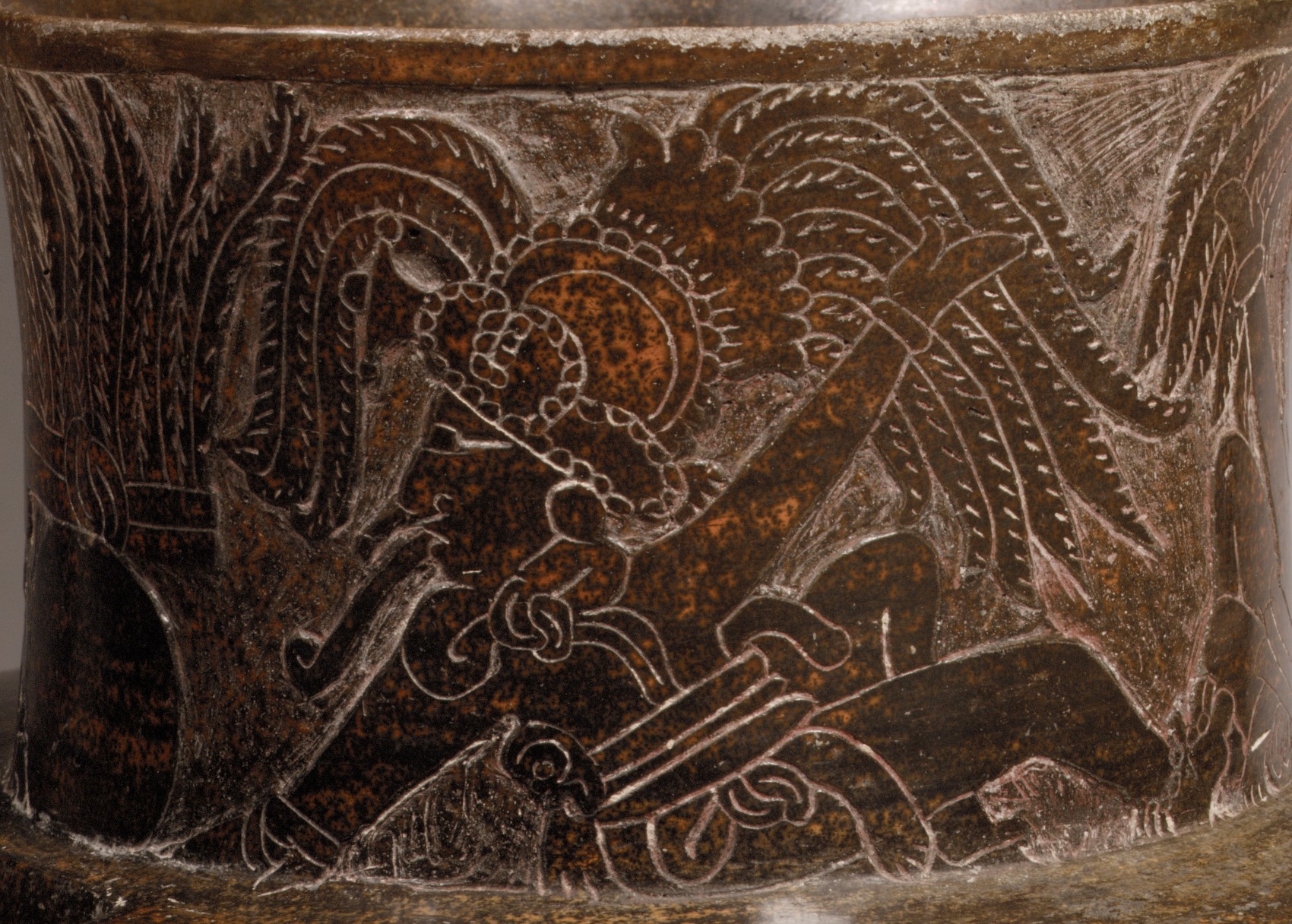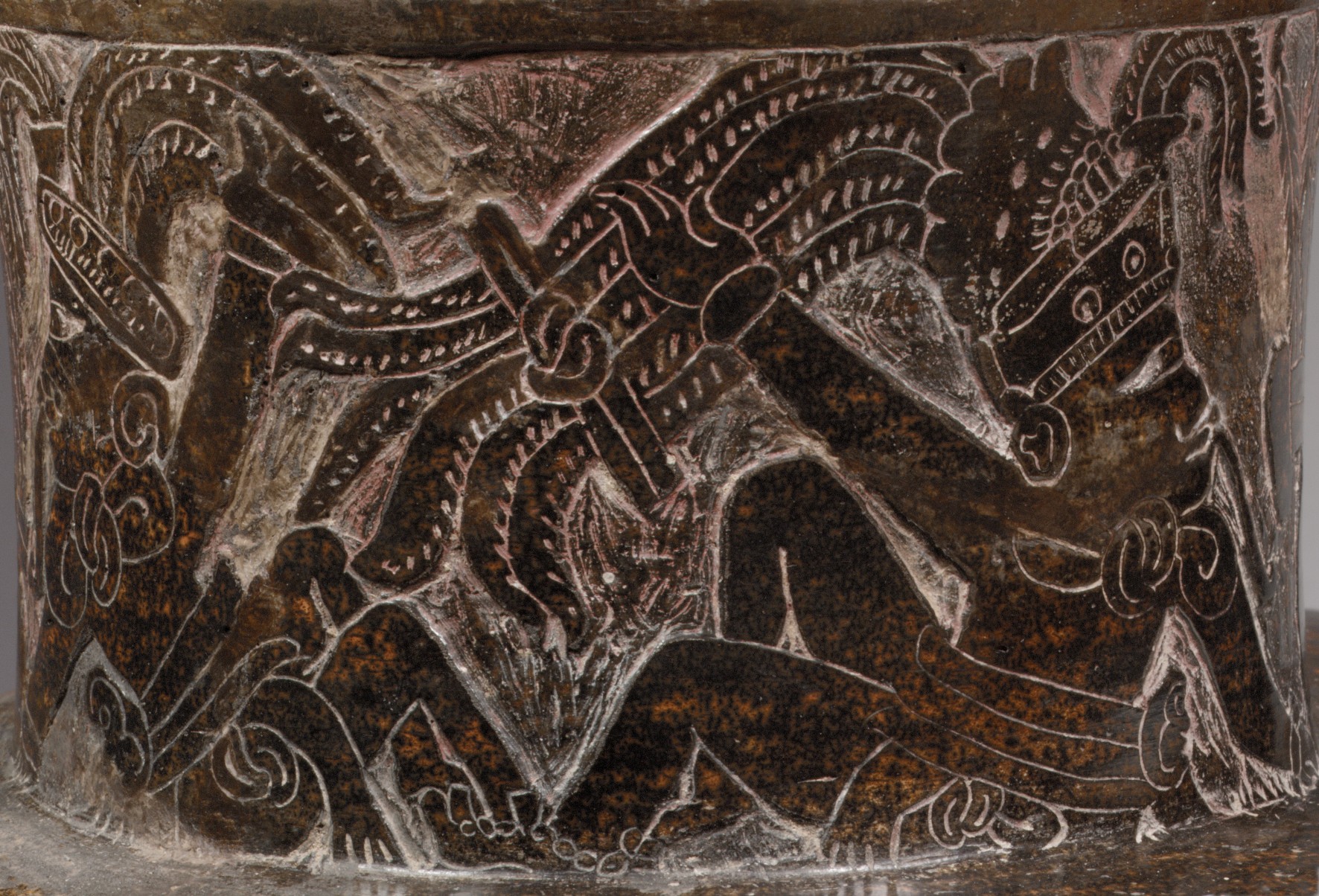Yoke-Form Vessel
Not on view
This unique tripod drinking vessel, made by Maya artists in a style associated with the great Central Mexican city of Teotihuacan, features a multi-layered visual narrative of the Mesoamerican ballgame. The three bulbous feet are incised with spiral motifs, which may refer to Teotihuacan depictions of extracted human hearts. Resting on the feet is a large u-shaped element, that represents an effigy ballgame belt or waist-guard (often referred to as a “yoke”). At each end of the u-shape, a head emerges from squared depressions; their closed eyes and vacant expressions suggest that they represent disembodied heads of vanquished enemies. On the main arc of the u-shape is a modeled element of a raised fist, which could refer to the removal of hands of captives as shown in other contexts. Though the versions of the ballgame varied throughout time and from place to place, sacrifice seems to have been a widespread feature.
Contiguous with the inner space of the effigy yoke is a cylindrical chamber, rising from the center of the yoke, from which someone would have consumed the liquid held within, probably savory chocolate. Contrasting with the smooth, burnished finish of the yoke’s surface, the cylinder and its lid have been gouged and incised, creating intricate scenes of ballplaying in relief. Four figures appear—two on the walls and two on the lid—in poses associated with ballplayers. They face each other, wearing similar knotted pectorals, belt assemblages, and large feathered headdresses. Long scrolls issue from their mouths, a widespread convention for representing speech in Teotihuacan-style art. Each of the headdresses has a different central element, which could indicate that the players come from different clans or political groups, and this ballgame scenario may have been an important diplomatic encounter.
Between each pair is an element that may indeed be a hieroglyphic symbol in the yet-unknown Teotihuacan language. The main element is a rubber ball, like those which players bounced around on ballcourts, but each is crowned by a different feathered element. The lower ball has a knotted band while the upper ball contains a lozenge-shaped hatched element with volutes protruding from its side. These compounds may refer to specific places, perhaps well-known royal capitals or specific ballcourts, though they remain undeciphered. The balls with feathered bundles also may represent offerings; rubber balls were frequently part of ritual activity and are depicted as being burned in other contexts. In that case, the ballplayers may be marking a specific event or ceremony with the offering of a ball.
Further reading
Aguilar-Moreno, Manuel. “Ulama: Pasado, presente y futuro del juego de pelota mesoamericano.” Anales de Antropología 49, no. 1 (2015), pp. 73–112.
Earley, Caitlin C. Stone Sculpture and Ritual Impersonation in Classic Veracruz. Metropolitan Museum Journal, v. 54 (2019), pp. 8-25. “The Mesoamerican Ballgame.” In Heilbrunn Timeline of Art History. New York: The Metropolitan Museum of Art, 2000–. http://www.metmuseum.org/toah/hd/mball/hd_mball.htm (June 2017)
Scarborough, Vernon L., and David R. Wilcox, eds. The Mesoamerican Ballgame. Tucson: University of Arizona Press, 1991.
Schele, Linda, and Mary Ellen Miller. The Blood of Kings: Dynasty and Ritual in Maya Art. New York and Fort Worth: George Braziller, 1986, pp. 248, 255, 259, pl. 97.
Taladoire, Eric. “El juego de pelota mesoamericano: Origen y desarrollo.” Arqueología Mexicana, no. 44 (2001), pp. 20–27.
Uriarte, María Teresa, ed. El juego de pelota en Mesoamérica: Raíces y supervivencia. Mexico City: Siglo Veintiuno Editores, 1992.
Whittington, E. Michael, ed. The Sport of Life and Death: The Mesoamerican Ballgame. London: Thames & Hudson, 2001.
Due to rights restrictions, this image cannot be enlarged, viewed at full screen, or downloaded.
This artwork is meant to be viewed from right to left. Scroll left to view more.




